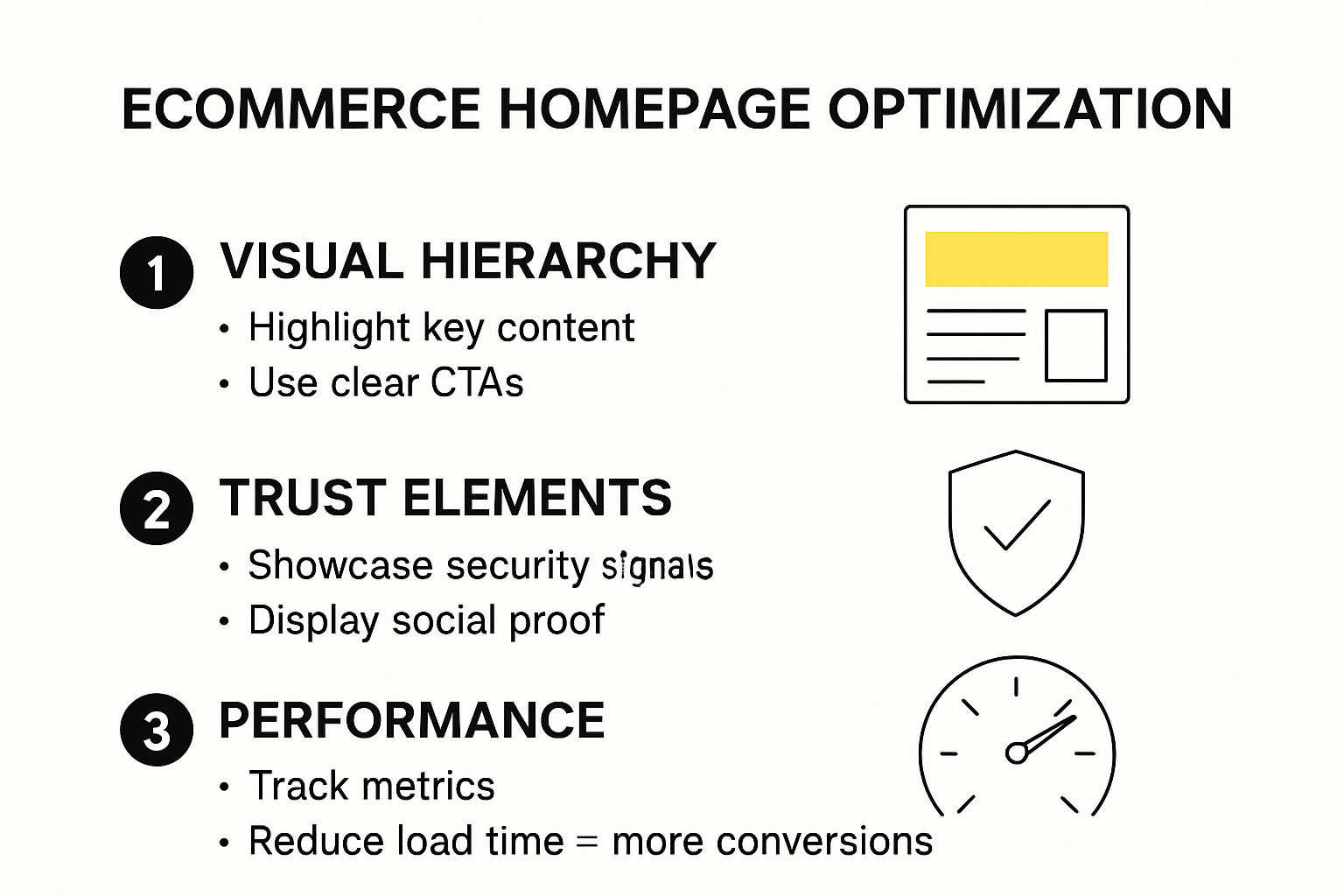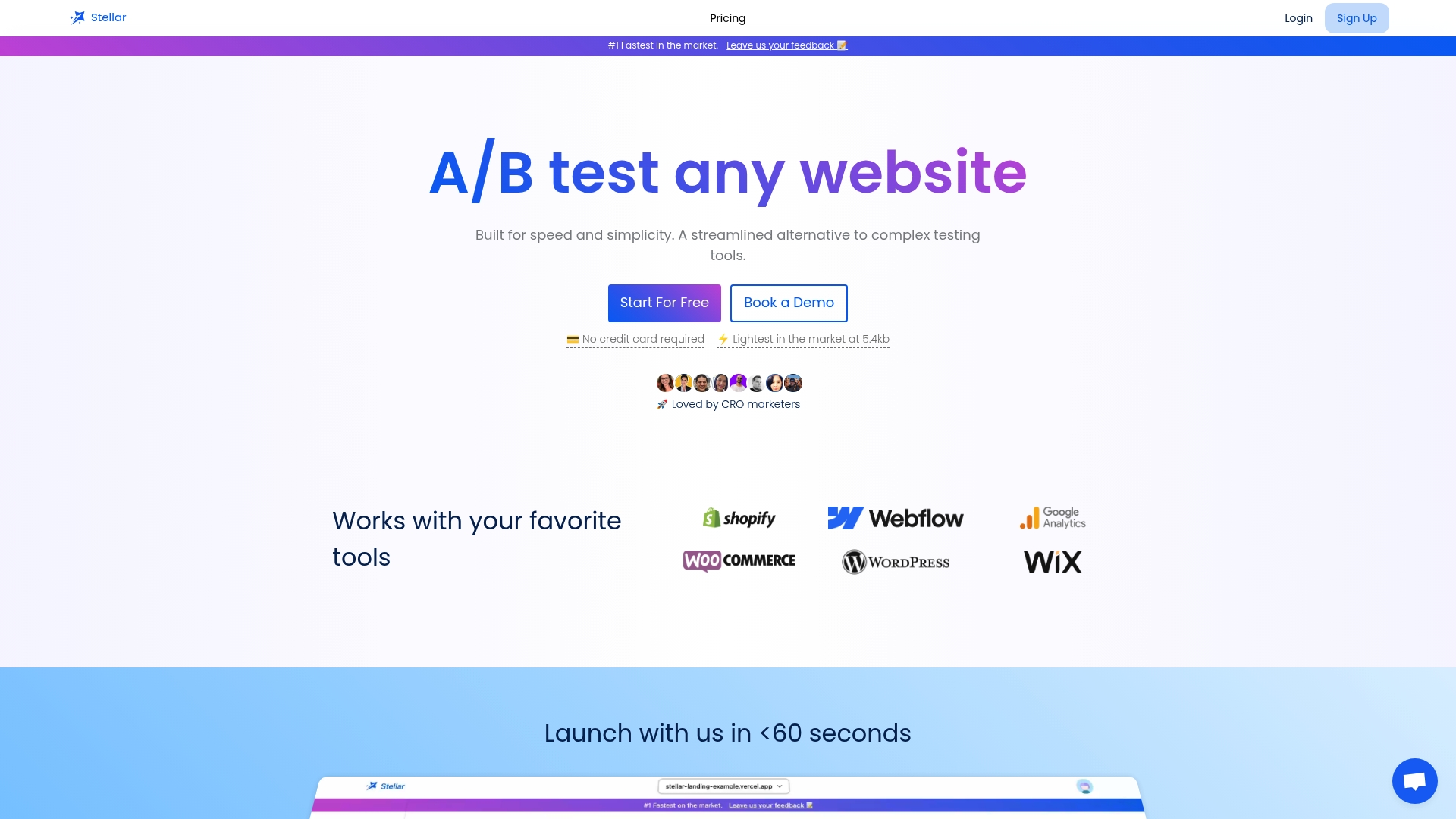
Ecommerce Homepage Optimization Strategies for 2025

Ecommerce homepage optimization is quickly becoming the battleground for customer attention and loyalty. Most people expect a site to load in under three seconds, but research shows that websites taking longer can see abandonment rates hit 53 percent. That number sounds brutal at first, yet it hides a powerful advantage for those willing to act. The real winners are the brands transforming their homepages through smarter testing and true personalization, not just flashy visuals.
Table of Contents
- Key Elements Of Ecommerce Homepage Optimization
- Best Practices To Boost Homepage Conversion Rates
- Personalization And A/B Testing For Better Results
- Tracking Performance And Continuous Improvement
Quick Summary
| Takeaway | Explanation |
|---|---|
| Optimizing Visual Hierarchy | Employ clear navigation, strategic information placement, and color psychology to guide user attention and enhance their understanding of the site. |
| Enhancing User Trust | Incorporate security badges, authentic customer reviews, and transparent policies to build trust that can increase conversion rates significantly. |
| Implementing Performance Optimization | Focus on reducing script loading, optimizing images, and ensuring mobile responsiveness to improve page load speed and overall user experience. |
| Leveraging Personalization | Utilize dynamic content and behavioral targeting to create personalized user experiences that align with individual preferences and drive engagement. |
| Continuous Performance Tracking | Develop robust analytics frameworks that enable real-time user behavior tracking and employ incremental testing for ongoing improvements in homepage performance. |

Key Elements of Ecommerce Homepage Optimization
Ecommerce homepage optimization requires a strategic approach that balances visual design, user experience, and conversion-driven elements. Successful homepages transform casual visitors into engaged customers through carefully crafted components that address user needs and business objectives.
Visual Hierarchy and User Attention
The visual structure of an ecommerce homepage determines how quickly users understand and navigate your site. Research on eye-tracking technology reveals that users make critical decisions within milliseconds of landing on a webpage. Critical design elements must guide user attention strategically.
Website loading speed plays a fundamental role in user retention. A comprehensive study demonstrated that websites taking over 3 seconds to load can experience abandonment rates approaching 53%. This stark statistic underscores the importance of optimizing page performance and visual elements.
Key visual hierarchy principles include:
- Clear Navigation: Intuitive menu structures
- Strategic Placement: Critical information above the fold
- Color Psychology: Using color to guide user attention
- Responsive Design: Consistent experience across devices
Trust and Conversion Elements
To help readers compare key trust and conversion elements discussed in this section, the table below summarizes their features and impact:
| Trust Element | Description | Impact on Conversion |
|---|---|---|
| Security Badges | Visual indicators of website safety | Increases trust |
| Customer Reviews | Authentic testimonials and ratings | Builds credibility |
| Clear Policies | Transparent shipping/return info | Reduces friction |
| Payment Options | Multiple secure payment methods | Enhances flexibility |
Building user trust is paramount in ecommerce homepage optimization. Research indicates that displaying security certifications, transparent return policies, and authentic customer reviews can increase conversions by 18%.
Essential trust-building components include:
- Security Badges: Visual indicators of website safety
- Customer Reviews: Authentic testimonials and ratings
- Clear Policies: Transparent shipping and return information
- Payment Options: Multiple secure payment methods
Learn more about optimizing conversion strategies for your online store.
Performance and User Experience
Homepage optimization extends beyond aesthetic considerations. Performance metrics directly impact user engagement and conversion rates. Mobile responsiveness, intuitive navigation, and fast loading times create a seamless user journey.
Critical performance optimization strategies include:
- Minimal Script Loading: Reduce unnecessary JavaScript
- Image Optimization: Compress visual assets
- Caching Mechanisms: Improve page load speed
- Adaptive Design: Ensure cross-device compatibility
By implementing these key elements, ecommerce businesses can create homepages that not only attract visitors but effectively convert them into loyal customers.

Best Practices to Boost Homepage Conversion Rates
Bosting homepage conversion rates requires a multifaceted approach that combines strategic design, psychological triggers, and data-driven optimization techniques. Successful ecommerce websites understand that conversion is not about a single element but a holistic user experience.
Responsive Design and Performance Optimization
Mobile traffic dominates online shopping experiences. Research from industry experts reveals that over half of ecommerce traffic originates from mobile devices. This critical insight demands a mobile-first approach to homepage design.
Page load speed emerges as a fundamental conversion driver. Studies demonstrate that a one-second delay can reduce conversions by 7%, with 53% of mobile users abandoning sites taking longer than three seconds to load. Implementing performance optimization strategies becomes non-negotiable.
Key performance considerations include:
- Minimal Resource Loading: Reduce unnecessary scripts
- Image Compression: Optimize visual assets
- Adaptive Layouts: Ensure seamless cross-device experiences
- Efficient Caching: Accelerate page rendering
Psychological Triggers and User Trust
The table below organizes the psychological triggers and user trust elements mentioned into a quick checklist for implementation:
| Element | Implementation Status |
|---|---|
| Social Proof (Testimonials) | |
| Security Indicators | |
| Transparent Policies | |
| User-Generated Content |
Converting visitors requires building immediate trust and creating compelling psychological triggers. Research on user-generated content indicates that customer reviews, testimonials, and authentic visual content can increase engagement by up to 79%.
Effective trust-building elements include:
- Social Proof: Prominent customer testimonials
- Security Indicators: Clear safety certifications
- Transparent Policies: Visible return and shipping information
- User-Generated Content: Real customer experiences and images
Explore advanced hero section strategies that maintain high performance to further enhance your homepage conversion potential.
Strategic Content and Call-to-Action Design
The homepage serves as the digital storefront, requiring carefully crafted content and intuitive navigation. Effective call-to-action design goes beyond aesthetic appeal, focusing on clarity, relevance, and psychological motivation.
Psychological design principles involve:
- Color Psychology: Using colors that evoke desired emotions
- Clarity in Messaging: Direct, benefit-focused communication
- Strategic Placement: Positioning CTAs for maximum visibility
- Urgency Indicators: Limited-time offers and scarcity messaging
By implementing these comprehensive strategies, ecommerce businesses can transform their homepage from a mere landing page into a powerful conversion engine that guides users seamlessly through the purchasing journey.
Personalization and A/B Testing for Better Results
Personalization and A/B testing represent critical strategies for ecommerce homepage optimization, enabling businesses to create dynamic, user-centric experiences that drive engagement and conversions. By leveraging data-driven insights and continuous experimentation, companies can transform their homepages into adaptive, high-performing digital storefronts.
Advanced Personalization Techniques
Research on real-time whole-page personalization reveals sophisticated frameworks that dynamically adjust homepage content based on individual user preferences. These advanced techniques go beyond simple demographic segmentation, utilizing complex algorithms to create truly individualized experiences.
A groundbreaking study demonstrated that optimizing homepage carousels through user affinity modeling can significantly enhance engagement metrics. By analyzing user behavior patterns, businesses can create dynamically ranked content that resonates more deeply with specific audience segments.
Key personalization strategies include:
- Dynamic Content Rendering: Adaptive product recommendations
- Behavioral Targeting: Customized user journeys
- Contextual Experience Design: Real-time content adjustments
- Predictive User Profiling: Anticipatory content presentation
Experimental Optimization Frameworks
Controlled online experiments demonstrate the complexity of modern A/B testing methodologies. Traditional approaches often fail to capture the nuanced interactions within personalized experiences. Researchers propose advanced frameworks like stacked incrementality testing to address these limitations.
Explore our comprehensive guide to A/B testing strategies to unlock deeper insights into experimental optimization.
Emergent testing methodologies showcase remarkable potential. A recent study utilizing Multi-Armed Bandit algorithms revealed impressive results: a 6.13% increase in click-through rates and a 16.1% improvement in conversion rates compared to standard homepage configurations.
Critical experimental optimization approaches include:
- Incremental Testing: Granular performance measurement
- Machine Learning Integration: Adaptive testing algorithms
- Multivariate Experimentation: Complex interaction analysis
- Continuous Optimization: Real-time performance adjustment
Strategic Implementation Considerations
Successful personalization and A/B testing require a holistic approach that balances technical sophistication with user experience principles. Businesses must develop robust data collection mechanisms, maintain strict privacy standards, and create flexible technical infrastructures that support rapid experimentation.
Effective implementation strategies involve:
- Robust Analytics Infrastructure: Comprehensive data collection
- Privacy-First Design: Transparent user consent mechanisms
- Agile Experimentation Processes: Rapid iteration capabilities
- Cross-Functional Collaboration: Alignment between marketing and technical teams
By embracing these advanced personalization and testing methodologies, ecommerce businesses can create homepage experiences that are not just responsive but predictive transforming casual visitors into engaged customers through intelligent, data-driven design.
Tracking Performance and Continuous Improvement
Continuous performance tracking represents the cornerstone of sustainable ecommerce homepage optimization. By implementing robust monitoring systems and embracing data-driven improvement strategies, businesses can create adaptive digital experiences that evolve with user expectations and technological advancements.
Advanced Performance Metrics and Analytics
For quick reference, the following table summarizes key advanced performance metrics and analytics to track for ecommerce homepage optimization:
| Metric | Description |
|---|---|
| Cross-Device Performance Analysis | Collect metrics across different devices |
| Real-Time User Behavior Tracking | Monitor granular user interactions |
| Conversion Funnel Optimization | Identify and address friction points |
| Comparative Benchmarking | Evaluate against historical/competitors |
Research on user interaction analysis reveals the critical importance of comprehensive performance tracking across different devices and browsers. Modern ecommerce platforms must develop sophisticated analytics frameworks that capture nuanced user behaviors and conversion metrics.
An industrial case study demonstrates that structured performance engineering interventions can dramatically enhance web application performance. These approaches go beyond traditional monitoring, creating proactive optimization strategies that anticipate and address potential user experience challenges.
Key performance tracking considerations include:
- Cross-Device Performance Analysis: Comprehensive metric collection
- Real-Time User Behavior Tracking: Granular interaction insights
- Conversion Funnel Optimization: Identifying friction points
- Comparative Performance Benchmarking: Continuous improvement metrics
Continuous Optimization Frameworks
Successful performance improvement requires more than passive data collection. Research on e-commerce platforms highlights the importance of dynamic ranking and real-time personalization to enhance user engagement and increase critical metrics like add-to-cart rates.
Learn more about optimizing conversion strategies to unlock advanced performance improvement techniques.
Effective continuous optimization strategies involve:
- Automated Performance Alerts: Immediate issue identification
- Machine Learning Optimization: Predictive performance improvements
- Incremental Experimentation: Controlled performance modifications
- Holistic User Experience Monitoring: Comprehensive performance assessment
Strategic Performance Management
Implementing a comprehensive performance tracking approach requires a holistic strategy that integrates technical capabilities with strategic business objectives. Organizations must develop flexible infrastructures that support rapid iteration and continuous learning.
Critical strategic considerations include:
- Cross-Functional Performance Teams: Collaborative optimization approaches
- Advanced Analytics Infrastructure: Robust data collection mechanisms
- Predictive Performance Modeling: Anticipatory optimization strategies
- Agile Improvement Processes: Rapid iteration and adaptation
By embracing these advanced tracking and optimization methodologies, ecommerce businesses can transform their homepages from static landing pages into dynamic, high-performing digital experiences that continuously adapt to user needs and market demands.
Frequently Asked Questions
What are the key elements of ecommerce homepage optimization?
Key elements include visual hierarchy, trust and conversion elements, and performance optimization to enhance user experience and drive conversions.
How can I improve the loading speed of my ecommerce homepage?
To improve loading speed, focus on minimizing script loading, optimizing images, using caching mechanisms, and ensuring responsive design for mobile devices.
What role does personalization play in ecommerce homepage optimization?
Personalization allows for dynamic content, behavioral targeting, and tailored user experiences, which can significantly enhance user engagement and boost conversion rates.
How can I track the performance of my ecommerce homepage?
You can track performance by implementing advanced analytics frameworks that monitor user behavior, conversion funnels, and comparative benchmarking against competitors.
Ready to Turn Homepage Visitors Into Loyal Customers?
After reading about the latest strategies for ecommerce homepage optimization, one thing stands out: you need to deliver fast, engaging, and personalized experiences that actually convert. Slow load times and generic content can cause users to abandon your site before they even see what you offer. When milliseconds matter and every visitor needs to see relevant offers, outdated testing tools only slow you down.

Take control of your optimization journey now. Choose Stellar, the leading A/B testing platform for real-time homepage improvements and data-driven insights. Empower your team with a no-code visual editor, lightning-fast script, and advanced personalization like dynamic keyword insertion. With a free plan for small businesses and proven impact on performance and conversions, there is no better moment to build the high-converting homepage your business deserves. Visit gostellar.app today and start turning insights into growth.
Recommended
- Ecommerce Conversion Rate Optimization Strategies for 2025
- E-Commerce Conversion-Optimierung 2025: Strategien für mehr Umsatz
- Optimiser la performance site e-commerce : stratégies clés 2025
- Conversion Rate Optimization Strategies for Marketers in 2025
- Ecommerce Conversie Optimaliseren: Onmisbare Strategieën voor 2025
- Proven Strategies to Increase Conversion Rate E-Commerce and Boost Your Online Sales
Published: 7/12/2025